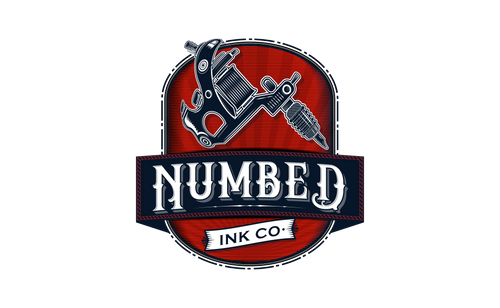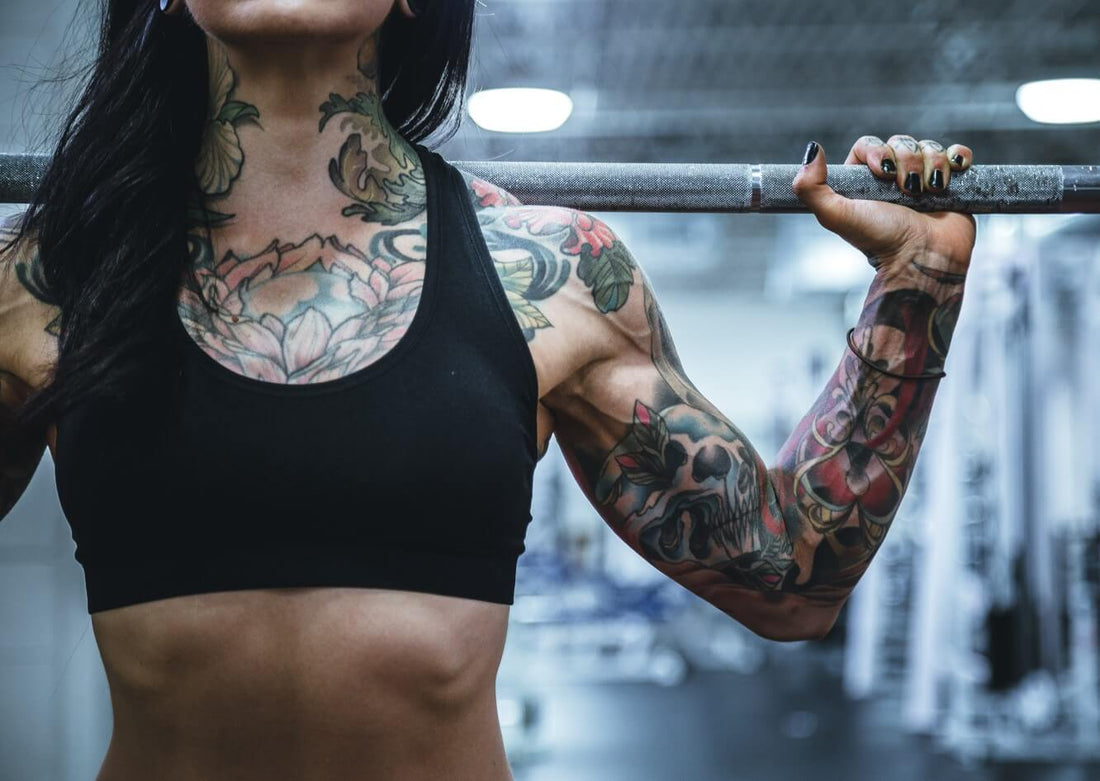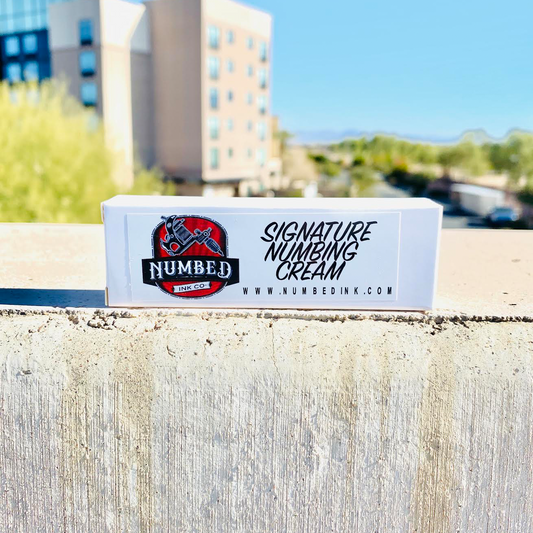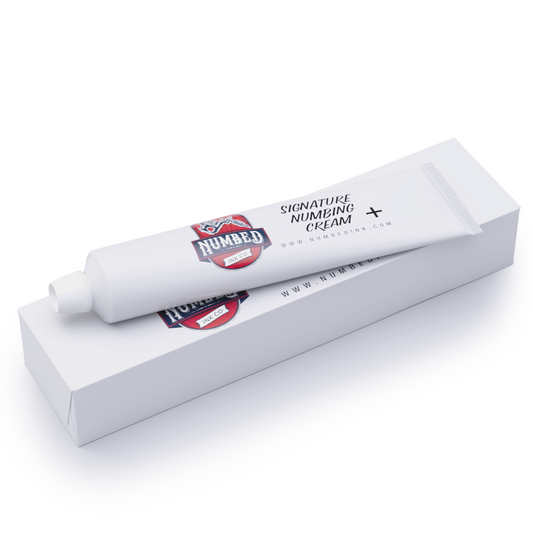If you’re a gym-rat or serious athlete that’s thinking about getting a tattoo, you’re likely wondering how that affects your training schedule. Or if you’ve recently added some new ink and you’re ready to get back to lifting, you may be wondering if you can workout at all.
We’ll start by answering that burning question on your mind: “Can I workout after a tattoo?” Yes, you can workout after getting a tattoo. But how soon and which type of workout will vary from person to person.
Exactly when and the intensity of your first workout will vary based on tattoo size, location, and your level of pain. For example, someone with a small wrist piece will likely be able to workout before someone who just finished up a full leg sleeve. And of course you’ll be able to go for a light walk before you pick up the barbell.
For most people, you can workout 2-3 days after your tattoo. Just make sure to wear loose-fitting clothing, shower immediately afterwards, and be conscious of your body movements. We’ll explain specific recommendations further down, but it’s important to understand why you’ll need a few days off from the gym after a tattoo.
Why you should wait to workout for at least a few days
There are few better feelings in the world than that after a good workout. You feel good and you look good too. Scientifically speaking, exercise releases endorphins, dopamine, serotonin, and norepinephrine in your body, which create that feeling of euphoria & happiness. This is the feeling described as “runner’s high,” which applies to all types of exercise.
And we’re huge advocates for healthy bodies & minds, but for the few days after a new tattoo, your body needs rest. Here’s why:
-
Prevent infection - Your skin is an open wound. And between your sweat and dirty gym equipment, it won’t be able to heal if it’s constantly fighting bacteria from these sources.
-
Prevent irritation - Whether you’re running, lifting weights, or doing yoga, your skin will rub against your clothing. Even with clean clothes on, the friction will cause fading & localized irritation, redness, and itching.
-
Prevent stretching & wrinkling - Your skin stretches & wrinkles as you move your body, which makes it difficult for your skin to repair itself. If your new tattoo is near a joint, avoid exercises involving this joint for at least 5-7 days. (i.e. avoid bicep curls after an arm tattoo).
- Prevent bleeding - It’s common for the area to bleed, especially in the first 48-72 hours. This is totally normal, but you want to limit the amount. Working out will elevate your blood pressure, causing more bleeding which may result in infections or ink damage.
How to workout after a tattoo

1. Avoid high-intensity workouts
Avoid high-intensity workouts for at least a week after getting your tattoo. Your skin needs time to heal and it won’t be healed when you wake up the next morning. Start slowly and progress your way back towards your typical workout routine over the next few days. It will take several weeks & months until all three layers of skin are fully repaired, but your body is resilient; you won’t damage your ink if you go all-out in the gym the following week.
2. Stay out of the pool
Water, aside from showering & cleaning your tattoo, poses a huge risk of infection. For that reason, it’s critical that you stay out of lakes, oceans, saunas, and hot tubs for at least a month. This means no swimming or pool workouts. And unfortunately, this goes for cold water too. So you’ll have to wait a few weeks until your next ice bath.
3. Protect your skin from the sun
Stay out of the sun for at least 4 weeks too. Prolonged UV exposure and un-sanitized water will cause infection, cracking, and fading. If you’re going for a long run or walk outdoors, cover your new design with loose-fitting clothing or apply a thorough amount of sunscreen to protect it.
4. Wear loose-fitting clothing
Tight clothing is popular at the gym, especially leggings, sports bras, and compression tops. But for the next 2 weeks, you need to swap your typical wardrobe out for clothes that are loose-fitting. Tight clothing increases friction and traps heat between the ink and your clothes, both of which will irritate your skin and permanently damage the design.
You don’t have to wear shirts & pants that are two sizes too big, just use common sense. Generally, a baggy t-shirt and shorts will be fine for most people. If you just got an ankle or calf tattoo, make sure to wear ankle socks and low-rise shoes. If you just got a thigh tattoo, throw on a pair of short shorts.
5. Wipe down the equipment
Most gyms do a decent job of sanitizing equipment regularly. But with dozens of other people using the same equipment as you, it’s better to be safe than sorry. Wipe down any equipment before you use it with a sanitary napkin or paper towel & spray bottle, whichever your gym offers. This includes barbells, dumbbells, treadmills, rubber mats, and anything else you may touch with your hands.
As a point of clarification, avoid bare skin contact between your bare skin tattoo and the gym equipment, even after sanitizing. You want to limit the chance of infection as much as possible. Similarly, don’t lift up your shirt or shorts every few minutes to touch it to make sure it’s okay. Your hands are covered in germs, you can check on it afterwards.
Make sure to clean the equipment when you’re done.
6. Clean & moisturize immediately afterwards

You should clean & moisturize your tattoo as soon as you’re done working out to clear the bacteria from your skin and reduce the chance of infection.
Take a cool shower to clean the area, as well as the rest of your body. Wash your hands thoroughly with soap before touching the tattoo, then gently scrub the area with an antibacterial, liquid soap.
After your shower, apply your tattoo moisturizer or unscented body lotion to prevent your skin from drying out and cracking.
When to workout after a tattoo
For the first 24 hours, you won’t be able to workout. Your body needs to rest and repair the damaged skin, and the first 24 hours are crucial to long-term healing. After that, you can slowly progress back towards your normal fitness routine.
The day after
Your first workout should be an easy one. Go for a long walk, do a low-intensity bodyweight workout in your home, or go through a beginner yoga flow. You can still burn 200-300+ calories with each of these without breaking much of a sweat.
At-home workouts are perfect because you can wear whatever you want, which you may not be able to do at your gym or outdoors. Take your shirt off or wear those flowy pants with the funky design, nobody’s watching.
When selecting a workout routine or yoga flow, avoid any that excessively stretch or contract the scabbing area.
After 2-3 days
After the first 48-72 hours, most people can resume their normal fitness routines at a lower intensity. But don’t walk into the gym ready to set a new personal record (PR), easy back into it at 70-80% for the next 3-4 days.
After 1 week
Around the 6-7 day mark, your skin should have healed enough to resume full intensity training. This means that you can push your body to the limit, as long as you continue to wear loose-fitting clothes, sanitize regularly, and clean & moisturize immediately afterwards.
After 4 weeks
Swimmers, rejoice. You can finally get back in the water around the 4 week mark, assuming you haven’t had any infections or delays in your healing process. For everyone else, you can show off your summer body at the pool, in the sauna, and ice baths too.
Tattoos look great, but they look even better on hard-earned physiques. So while it’s important to train hard, your body deserves a few days off to recover. Your skin will begin to heal and your muscles will be well-rested once you’re ready to get back in the gym. As long as you follow the basic guidelines for clothing, sanitizing, cleaning, and moisturizing, your fitness regimen won’t be affected too much.



